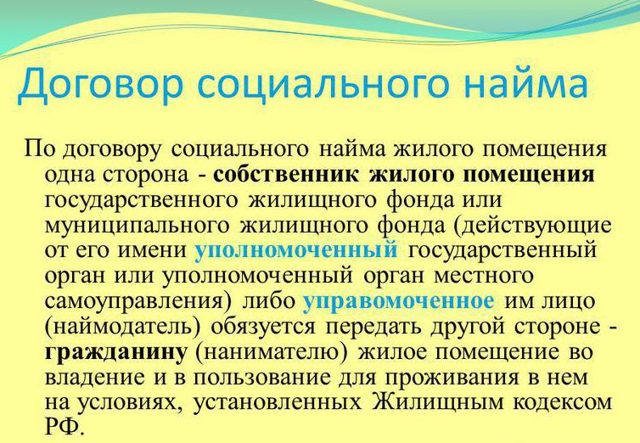Living space standards: what you need to know
Let's immediately understand the concepts. Living space is not the square footage of an apartment. According to the laws, living space is the size of rooms, i.e., premises intended for living. The kitchen, bathroom, and storage rooms are not considered residential “squares.” But they are taken into account when determining the total area of housing - this is the area of all the premises of the apartment, except for the balcony, loggia, and terrace. When developing standards, government agencies usually consider living space.
The living area of the apartment includes only the area of living rooms
The living space norm is the minimum number of residential “squares” allotted to a person by law.
Laws on living space standards
The basic law on area standards is the Housing Code of the Russian Federation (hereinafter referred to as the Housing Code). It contains terms and general provisions. Specific figures for areas should be sought in the laws of the constituent entities of the Russian Federation and in municipal documents - acts of villages, cities, municipal districts.
There is information about the standards for some citizens - beneficiaries and state employees - in special laws, for example, in the Federal Law of November 24, 1995 N 181 “On the Social Protection of Disabled Persons in the Russian Federation”, the Federal Law “On Veterans” of January 12, 1995 N 5, Federal Law “On the Status of Military Personnel” dated May 27, 1998 N 76, etc.
Types of living space standards
In Russia there are 4 standards for living space:
- sanitary standard;
- provision rate;
- accounting standard;
- social norm.
All these standards show the minimum territory a person needs to live. The difference is that each norm is applied only in specific situations designated by law. For example, where the sanitary standard works, the accounting standard does not work, and so on. Therefore, the numerical indicators for each norm are different; they, as a rule, do not coincide with each other.
All standards are calculated as the number of square meters. m. for 1 person. If a family receives an apartment, then the value of the norm must be multiplied by the number of family members.
Why are living space standards needed?
The state needs rationing of residential meters for various purposes:
- calculate the size of the premises that need to be provided to a person or family for a more or less normal life (under a social rental agreement, in a dormitory, when moving from emergency housing, etc.);
- calculate the amount of the subsidy if a citizen applies for it;
- if someone wants to live in an apartment, find out if there is enough space for everyone;
- determine the cost of utilities, the amount of preferential discounts.
How many square meters per person (norm)
It should be taken into account that now the funds of municipal and public housing, if they increase, are extremely small. On the contrary: until 2020, housing privatization is taking place in our country, and, accordingly, a significant part of municipal apartments continues to be re-registered as the property of citizens. Apartments in new buildings practically do not become the property of the state or local government.
At the same time, housing cannot be provided to foreigners if the Russian Federation has not concluded a corresponding international treaty with their state. In addition, in any case, homeowners are excluded from the list of candidates for concluding a social rental agreement - no matter what kind of housing it may be.
11 Mar 2020 lawurist7 141
Share this post
- Related Posts
- What is the cost of living in the Moscow region in 2020 for pensioners
- Where is a child's birth certificate changed when the mother's surname changes?
- Chernobyl victims in Almaty
- Payment for guardianship of 14
Norm for providing living space
The norm for the provision of living space is the minimum size of housing that a person can receive from the municipality under a social tenancy agreement (Article 50 of the Housing Code). The specific number of meters is determined by local authorities based on the capabilities of the municipal housing stock. Therefore, national figures may vary. But the most common values for the provision rate are as follows:
- 33 sq. m. - if one person lives;
- 42 sq. m. - for two people;
- 18 sq. m. per person - for a family of 3 or more people.
The living area of the apartment according to the provision rate will depend on the number of people in the family. For example, if the region has a “classical” provision norm, then a family of 4 people will receive housing measuring 72 square meters. m. (18 x 4 = 72).

Social housing size hiring is calculated based on the provision rate and the number of people in the family
The provision norm only works if the family rents housing under a social tenancy agreement. It is concluded with municipal or regional authorities. The essence of the agreement: the family uses housing for free, which belongs under the right of ownership to the city or region. To use social hiring, the family must be simultaneously recognized as low-income and in need of improved living conditions. The procedure for recognizing the poor in each region is different. As a rule, a family is considered low-income if its total income is not enough to support all family members, because each person receives an amount less than the regional subsistence level. But the criteria for recognizing a family in need of improved housing conditions are the same throughout the country. They are listed in Art. 51 LCD:
- the family does not have their own home;
- citizens did not enter into a social rental agreement;
- live in the same room with a dangerously ill person;
- the house is recognized as unsafe;
- living space is less than the accounting norm.
Minimum housing standards Tyumen
In accordance with Articles 14, 50 of the Housing Code of the Russian Federation, Article 8. Establish a registration standard for the area of residential premises, the minimum size of the area of living premises, on the basis of which the level of provision of citizens with the total area of living premises is determined in order to be registered as those in need of residential premises in size 15 sq.
Tell me how many square meters there should be for 4 people.
Letter and line spacing: Standard Medium Large. On the establishment of an accounting standard for the area of residential premises, the amount of income and the value of property in order to recognize citizens as low-income, as well as the standard for providing the area of living premises under a social tenancy agreement Share. Title of the document On the establishment of an accounting norm for the area of residential premises, the amount of income and the value of property in order to recognize citizens as low-income, as well as the norm for providing the area of living premises under a social tenancy agreement Type of document Decision.
The article talks about the norms and procedure for providing housing to tenants under a social tenancy agreement. This also includes indicators of the average cost of one square meter of housing in a particular region and what kind of housing is taken into account - social, which will be provided under a social rental agreement, or commercial, which can be purchased by obtaining a special housing certificate.
Accounting standard for living space
The accounting norm (hereinafter referred to as UR) is a minimum of “squares” by which it is determined whether a person/family can be classified as in need of improved living conditions. If the living space is less than the UL, the family has the right to improvements. UN is a beacon of need for better housing.
The provision rate and the UN are similar, but not the same. Before concluding a social contract. hiring accounting norm works - it shows whether there is a right to social services at all. hiring And during the registration of social hiring there is a provision norm, which determines how many sq. m. allocate to the family. The numerical values of these two norms are close, but not equal. The UL cannot be greater than the provision norm.
The UN indicator is set by local authorities, so each city has its own.
Let's look at an example. A family of 3 lives in a one-room apartment with an area of 27 square meters. m., in Krasnodar. The family wants to get on the waiting list for improved housing conditions. To do this, you need to understand: their apartment is less than the accounting norm or more. The UN indicator in Krasnodar is 10 square meters. m. per person. We count: 3 people x 10 sq. m. = 30 sq. m.
That is, for a minimum comfortable stay, a family needs 30 “squares”. Now the area of their apartment is 3 square meters less. Consequently, the family can register to improve their living conditions.
What is this indicator and how to calculate it
The standard living space is the same square footage per person for his normal life.
The concept of “norm” is relative. There are at least 3 types of this indicator:
- Minimal. The minimum is typical for residents of hostels and shunting funds.
- Provision rate. We are talking about the allocation of living space to a citizen through the conclusion of a social tenancy agreement.
- The accounting area must exceed the provision norm in area. It determines whether the state is obliged to provide more living space than a large family owns or not.
There are also a number of factors that influence the final decision on the provision of living space:
- number of family members;
- the degree of provision of living space in specific regions;
- type of residential premises;
- other.
The calculation of the indicator is used in the following situations:
- Calculation of monthly payments for living space (calculation of utilities);
- For the settlement of temporary residents (renting out housing);
- The property is divided between the owners;
- Eviction of the tenant;
- Confirmation by the tenant of the right to receive additional living space.
The minimum square meters per person is 6 sq. m. In case of violation of this minimum, a citizen of the Russian Federation has the right to go to court for further proceedings.
The sanitary standard is 6 sq.m. valid in the following cases:
- Dedicated space in a dormitory (for example, for students during their studies);
- Flexible housing (for the duration of ongoing repairs, construction or relocation of citizens to new housing).
Required condition – min. The ceiling height must be more than 2.1 m.
Legislative bodies may review the grounds on which a person can be placed in a flexible fund. If the apartment was taken away for debts, government authorities may provide the debtor with a temporary place of residence to pay off the debt.
Size
Referring to housing legislation documents, this is a mandatory minimum square meters that a citizen can claim when drawing up a social tenancy agreement. According to Article 50 of the RF Housing Code, each municipality must establish its own indicator values.

The provision rate varies in different cities of Russia.
Region, CityMinimum value, sq.m. Average value, sq.m. Maximum value, sq.m.
| Moscow region, Moscow | 18 | 18 | 18 |
| Voronezh region, Voronezh | 14 | 14 – 18 | 18 |
| Yaroslavl region, Yaroslavl | 17 | 17 | 17 |
| Belgorod region, Stary Oskol | 18 | 18 | 18 |
| Belgorod region, Belgorod | 18 | 18 | 18 |
| Belgorod region, Gubkin | 17 | 17 – 18 | 18 |
| Omsk region, Omsk | 18 | 18 | 18 |
Consequently, housing standards below these figures have no right to exist. Otherwise, the citizen has the right to bring the case to trial.
At the federal level, the standard for military families is established everywhere, the conditions apply throughout the Russian Federation. The all-Russian norm for the military is 18 square meters. m.
Accounting
The accounting norm applies to those citizens who live in social or municipal housing.
As with the provision rate, accounting is regulated at the local level. Therefore, it can vary even in one regional center.
Region, City Value, sq.m.
| Moscow region, Moscow | 10 (for individual apartments) |
| 15 (for communal apartments) | |
| Voronezh region, Voronezh | 11 |
| Yaroslavl region, Yaroslavl | 12 |
| Belgorod region, Stary Oskol | 14 |
| Belgorod region, Gubkin | 13 |
| Belgorod region, Belgorod | 15 |
| Omsk region, Omsk | 15 |
According to Article 50 of the Housing Code of the Russian Federation “Norm for the provision and accounting norm of the area of residential premises,” the establishment of the accounting value of the indicator is carried out by local government bodies. However, it should not exceed the provision rate, which is also established by the local government.
It will be useful for tenants and landlords to familiarize themselves with Article No. 49 of the Housing Code of the Russian Federation “Provision of residential premises under a social tenancy agreement,” part three. The article talks about the norms and procedure for providing housing to tenants under a social tenancy agreement.
According to Article No. 105 of the Housing Code of the Russian Federation, the minimum prescribed sanitary indicators for people who live in a dormitory are 6 square meters.
More on the topic SanPiN for residential premises of apartment buildings
Section No. 3 (chapters No. 7 and No. 8) in the Housing Code of the Russian Federation is devoted to residential premises that are provided under social tenancy agreements.
Social significance
Minimum and average indicators for one person out of three in a family:
- The minimum value is 16 sq. m.
- The average for the Russian Federation is 18 square meters. m.
For military personnel
The official mention of providing housing for military personnel is indicated in article of Federal Law No. 117, which came into force at the beginning of 2005: the minimum provision and the permissible limit for exceeding this norm are indicated.
If a military personnel obtains a mortgage, these indicators will not be taken into account; Only in the case of housing subsidy calculations are the indicators of the provision rate taken into account.
A military officer discharged before the end of his 10-year service period has the right to claim a minimum of 18 square meters. Moreover, 18 square meters is the sanitary norm for him and his entire family.
Officers who have received the honorary title of the Russian Federation can apply for an increase in the provision rate to 25 square meters.
According to Rosstat research, approximately 26% of citizens for 2017-2018 are entitled to all kinds of compensation, benefits and subsidies:
- Military personnel (active and retired);
- Police personnel;
- Persons with disabilities;
- Large families.
The following can count on additional living space (to the norm established by law):
- Police officers. There are no restrictions on the increase in living space by the government at the federal level.
- Bailiff of the Constitutional Court of the Russian Federation. Limit – up to 20 square meters.
- Investigative Committee employees can apply for an increase in living space to 20 square meters. m.
- Military personnel holding the title: Hero of the USSR have the right to increase their living space to 20 square meters. m.;
- holder of the Order of Glory, have the right to increase the living space to 20 square meters. m;
- Hero of the Russian Federation, are able to claim 20 square meters. m.;
- from the colonel, has the right to claim an increase in living space to 25 square meters. m. (but not less than 15).
Sanitary standards for living space
The sanitary standard (hereinafter referred to as SN) is the minimum indicator of how many square meters a person needs to live. The room cannot be smaller than CH, otherwise it will be impossible to live in it. The sanitary standard is common for the entire country and is equal to 6 square meters. m. per person. Because of its modesty, according to the SN, the size of premises is calculated only for temporary accommodation of people: rooms in a dormitory (Article 105 of the Housing Code), in flexible housing - temporary housing, which the state provides in special cases, for example, during a major renovation of a house (Article 106 LCD).
For example, the area of a dorm room is 25 square meters. m. This means that a maximum of 4 people can be accommodated in such a room (25 sq. m./6 sq. m. = 4.17).
Social norm of living space
A social norm is a residential square footage standard that is used when necessary:
- calculate the amount of compensation for utility bills;
- determine whether citizens are eligible to participate in a regional or local housing program;
- calculate the amount of subsidy for the housing program.
There may be other cases of application of a social norm - they vary depending on the region or municipality.
The federal standard for this norm is 18 square meters. m of total area per person (this does not mean the area of living rooms, as in previous standards, but the area of rooms + household premises). Regions and municipalities have the right to set their own social norms, which may be more or less than 18 square meters. m., focus on the total or living area.
Let's look at an example. A family of 4 lives in Novosibirsk in an apartment of 60 square meters. m. The size of their ideal housing is 18 square meters. m. x 4 people = 72 sq. m. (The social norm in Novosibirsk corresponds to the federal standard). It turns out that now the family lives in a small apartment, so they can participate in the housing program. If, of course, it meets other requirements of a specific program (young family, low-income people, etc.). The family will receive compensation for utility bills for the entire apartment.
Let’s say a family of 2 people lives in the same apartment. 18 sq. m. x 2 people = 36 sq. m. They are no longer included in housing programs, because the apartment area is sufficient. The family will receive compensation for utility bills for the rationed 36 square meters. The remaining 24 sq. m. (60 - 36 = 24) will have to be paid in full.
Standard Area Per Person in an Apartment in Tyumen
On the procedure for registering citizens in need of improved housing conditions and providing residential premises in the Tyumen region. Adopted by a resolution of the Tyumen Regional Duma from this Law in accordance with the Constitution of the Russian Federation, the Law of the Russian Federation "On the Fundamentals of Federal Housing Policy", the Housing Code of the RSFSR, other regulatory legal acts of the Russian Federation and the Tyumen Region establishes a unified procedure for recording citizens in need of improved housing conditions , and the provision of residential premises in houses of state and municipal housing stock in the Tyumen region. The accounting standard for housing area in the Tyumen region is set at 15 square meters. Citizens who permanently reside in compliance with the registration rules in a given locality of the Tyumen region are accepted for registration for the provision of residential premises, unless otherwise provided by current legislation.
In Tyumen what is the norm per person
The grounds for recognizing citizens as needing residential premises are determined by Article 51 of the Housing Code of the Russian Federation. Such grounds include the provision of citizens with a total living space per family member that is less than the accounting norm in the city of Tyumen, the accounting norm is 15 square meters. In this case, the total total area of all residential premises occupied by a citizen and or members of his family under social tenancy agreements and or owned by them is taken into account.
Description of the page: the norm of square meters per person in Tyumen from professionals for people. There are quite a lot of calculations according to which it is possible to determine the number of square meters allocated per person in our state. Dear readers! Our articles talk about typical ways to resolve legal issues, but each case is unique.
The question of how many square meters per person becomes decisive in many situations. The Housing Code of the Russian Federation has Article 50, which is devoted to this issue. The indicator remains at different levels in different regions and subjects. In the constituent entities of the Russian Federation, responsibility for setting individual standards falls on the shoulders of local authorities. The size of such a norm cannot exceed the size of the provision norm established by this body. At the level of federal legislation, the rules are defined as follows. The social norm is the minimum necessary housing that must be allocated to the population when the housing stock is distributed among them.
How many square meters of living space are allowed per person?
In order to be recognized as needy, a family must have less than the accounting norm of total area per person, that is, for a family of 4 people less than 60 square meters. In accordance with Articles 14, 50 of the Housing Code of the Russian Federation, Article 8. Establish a registration standard for the area of residential premises, the minimum size of the area of residential premises, on the basis of which the level of provision of citizens with the total area of living premises is determined in order to register them as those in need of residential premises in the size of 15 sq. In order to recognize citizens as low-income and provide them with residential premises of the municipal housing stock under social tenancy agreements in accordance with the Housing Code of the Russian Federation, establish the amount of income per each family member in the amount of the subsistence minimum per capita established for the Tyumen region at the time of filing applications for registration of those in need of residential premises provided under social tenancy agreements; the amount of the value of property owned by family members and subject to taxation - rubles at the time of filing an application for registration of those in need of residential premises provided under social tenancy agreements. Establish a standard for the provision of residential space under a social rental agreement, the minimum size of the residential area, on the basis of which the size of the total area of residential premises provided under a social rental agreement is determined in the amount of at least 18 square meters.
We recommend reading: Will the Arrest on the Sber Book Apply to an Open Bank Card
Hello! I live in an apartment with a total area of 70.8 sq. m., living area is 42.9 sq. m. 4 people are registered. The apartment was privatized for 4 people in equal shares, but my father died and his share was transferred to my mother, but my sister and I were left with equal shares (17.7 each). Now my husband is registered instead of my father (not officially married), but he was not included in the privatization. It turns out that my husband lives with me on my privatized part (8.85 sq.m per person). Can I get in line to receive a plot of land from the state? Republic of Crimea, Kerch.
Depending on the region of the country, this norm differs, since according to the law, individual entities can independently establish it and in some cases this norm may exceed the standards established by the federal government, but this indicator cannot be lower than the provision norm.
How many square meters per person?
exception is the sanitary standard , which is indirectly (without mentioning the word “sanitary”) established in the current edition of the code. Therefore, any other information about the established sizes of living space with reference to the Housing Code is outdated .
whether the privatization procedure was carried out, whether the family has benefits, etc. When evicting from privatized housing, the owner must receive equivalent housing, regardless of how many citizens were registered or lived there. When calculating preferences for payment for housing and communal services, the specified social norm is used to determine financial support for citizens in the form of benefits. Municipal and regional authorities have the right to set their own standards, so you should first consult how many square meters are allocated per person in 2020 by region.1.
These grounds include the provision of citizens with a total living area per family member that is less than the accounting norm (in the city of Tyumen, the accounting norm is 15 sq.m.). In this case, the total total area of all residential premises occupied by a citizen and (or) members of his family under social tenancy agreements and (or) owned by them is taken into account.
Standard Square Meters Per 1 Person in Tyumen
Citizens who do not belong to the categories of persons specified in part one of this article are provided with residential premises in the state and municipal housing stock on the terms of a commercial lease agreement or are acquired by them as property in the prescribed manner.
If the premises do not meet these standards, the family can collect the necessary documents and submit an application to get on the waiting list for improved living conditions. Families with low incomes, when utility bills make up a large part of family expenses, can submit documents to subsidize utility services. They will be provided with compensation for only part of the living space within the social norm. Accounting norm and norm for providing living space The concepts of these terms are given in Article 50 of the Housing Code of Russia. The provision norm is considered to be the smallest number of residential meters for calculating the total area of the premises that will be provided to the family under a social lease agreement. Most regions take 18 square meters as a basis. m. area, they are used as the provision norm.
Living space standards for certain categories of citizens
Federal, regional and local authorities may establish special living space standards for certain categories of citizens. The numerical values of the standards, conditions of application, categories of citizens are prescribed in federal, regional and municipal laws, respectively.
As a rule, special categories of citizens include beneficiaries and public sector employees.
Preferential categories of citizens:
- disabled people,
- orphans,
- large families,
- combat veterans,
- families who have lost their breadwinner,
- citizens exposed to radiation (Chernobyl, Semipalatinsk),
- Heroes of the Soviet Union, Heroes of the Russian Federation and full holders of the Order of Glory,
- Heroes of Socialist Labor, Heroes of Labor of the Russian Federation, full holders of the Order of Labor Glory.
Public sector employees:
- judges,
- prosecutors,
- employees of the Ministry of Internal Affairs,
- military personnel,
- teachers.
A separate federal law has been adopted for each category, which specifies the right of these citizens to special living space standards. Specific numbers of standards will be indicated in the laws of the region or acts of the local administration, so first of all it is worth studying these documents.
It is understood that special categories of citizens receive housing under a social contract. hiring Only in this case can we talk about special area standards. In order to exercise their right, beneficiaries and state employees must need improved housing conditions, that is, live in a room the size of which does not meet the regional registration standard, and sometimes citizens must meet other requirements (length of service, rank). The requirement of “low income” does not apply to beneficiaries and state employees.
Let's look at what the housing benefit is for some special categories of citizens.
Disabled people
A person suffering from a serious illness (the list of diseases is established by the Government of the Russian Federation) can count on housing that is more than the standard provided. Housing can be increased by a maximum of two times (Article 17 of the Law “On Social Protection of Disabled Persons in the Russian Federation”).
Heroes
Heroes of labor have the right to receive housing from the state out of turn, while the size of housing is 15 “square meters” larger than the provision norm (Article 3 of the Law “On the provision of social guarantees to Heroes of Socialist Labor, Heroes of Labor of the Russian Federation and full holders of the Order of Labor Glory”).
Heroes of the USSR and heroes of the Russian Federation also apply for housing out of turn, but for them the size of the home will increase by 20 sq.m. (Article 5 of the Law “On the status of Heroes of the Soviet Union, Heroes of the Russian Federation and Full Knights of the Order of Glory”)
Employees of internal affairs bodies
Police officers, employees of the Ministry of Internal Affairs and the National Guard have the right, according to Art. 7 of the Law “On Social guarantees for employees of the internal affairs bodies of the Russian Federation”, to obtain housing on social security. will hire:
- 33 sq. m. - per person,
- 42 sq. m. - for a family of two people,
- 18 sq. m. - for each family member (if the family consists of three or more people).
Those who have reached the rank of colonel and those who have academic titles can receive an additional 20 “squares” of living space.
Military personnel
Military personnel receive social housing. I will hire at the rate of 18 “squares” per person. Additional 15–25 sq. m. can be received by colonels, teachers of military educational institutions, commanders of military units (Article 15.1 of the Law “On the Status of Military Personnel”).
Minimum housing standards Tyumen
For most Russians, the housing issue remains the most difficult and pressing. Many are trying to resolve the situation with an insufficient number of meters for normal and comfortable living in various ways. Often you have to resort to mortgage lending. But not everyone can afford to purchase housing using their own and borrowed funds. In some cases, government assistance is necessary. And here a logical question arises: how many square meters of living space is assigned to each person?
What is the standard living space per person?
On establishing an accounting standard for the area of residential premises, the amount of income and the value of property in order to recognize citizens as low-income, as well as the standard for providing the area of residential premises under a social tenancy agreement. In accordance with Articles 14, 50 of the Housing Code of the Russian Federation, Article 8. Establish a registration standard for the area of residential premises, the minimum size of the area of living premises, on the basis of which the level of provision of citizens with the total area of living premises is determined in order to register them as those in need of residential premises in the size of 15 sq. In order to recognize citizens as low-income and provide them with residential premises of the municipal housing stock under social rental agreements in accordance with the Housing Code of the Russian Federation, establish the amount of income per each family member in the amount of the subsistence minimum per capita established for the Tyumen region; the amount of the value of property owned by family members and subject to taxation is rubles.
To determine the size of the living space attributable to each family member of the applicant, the total area of all residential premises or parts thereof, in respect of which any of the family members has an independent right of use or ownership, is determined and divided by the number of family members.
Table: living space standards in Russian regions
| Region/city | Provision rate (sq.m. per person) | Accounting norm (sq. m. per person) | Social norm (sq. m. per person) |
| Moscow | 18 | 10 in a separate apartment 15 in a communal apartment | 9 |
| Saint Petersburg | 18 | 9 in a separate apartment 15 in a communal apartment | — |
| Nizhny Novgorod Region | 33 - for 1 person 42 - for 2 people 18 - for each person in a family of 3 or more people | — | 33 - for 1 person 42 - for 2 people 18 - for each person in a family of 3 or more people |
| Samara Region | 26 - for a person living alone 14 - for everyone in a family of 2 or more people 18 - disabled people 33–36 - veterans | 14 in a separate apartment 15 in a communal apartment 12 - disabled people 14 - veterans | — |
| Kazan | 33 - for 1 person 42 - for 2 people 18 - for each person in a family of 3 or more people | 12 | — |
| Krasnodar | 33 - for 1 person 42 - for 2 people 18 - for each person in a family of 3 or more people | 10 | — |
| Ekaterinburg | 16 | 10 | — |
| Novosibirsk | 15 | 12 | 33 - for 1 person 42 - for 2 people 18 - for each person in a family of 3 or more people |
| Krasnoyarsk | 15 18 - for a person living alone | 12 | — |
| Khabarovsk | 18 - for everyone in a family of 2 or more people 20 - for a person living alone | 12 | — |
Video: about living space standards - history and modernity
There are 4 living space standards: accounting, sanitary, social and provision standards. Standard indicators differ from each other and are most often determined by local authorities. Each norm is applied in a special situation designated by law. However, the task of the norms is the same: to determine how many squares a person is entitled to. For beneficiaries and public sector employees, the state can establish special living space standards.
- Author: ozakone
Rate this article:
- 5
- 4
- 3
- 2
- 1
(6 votes, average: 2.3 out of 5)
Share with your friends!








